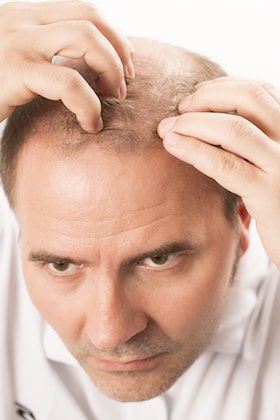Pattern Hair Loss Cure – New Molecule Might Hold the Key
The search for a way to prevent hair loss is ongoing as scientists try to identify a way to prevent pattern hair loss. Researchers at the University of California, Irvine (UCI), say they have identified a signaling molecule that is known as SCUBE3. The experiments conducted by the research team are said to have shown this signaling molecule has the potential to cure a type of hair loss that is prevalent in both male and female patients. It was reported that this chemical compound works to instruct hair stem cells to begin dividing. In turn, this can trigger new hair growth as shown by the results they viewed after the molecule was injected into human hair follicles that were grafted onto the skin of mice being examined by the researchers.
SCUBE3 – How it Signals Hair Growth
 According to the researchers at UCI, SCUBE3 acts upon a cell population that is in the skin. This cell population is known as dermal papilla (DP) and these cells are known for the important role they play in the regulation of the development and growth of hair follicles. In addition, the significance of DP cells is also elevated by the fact that they are multi-potent stems cells which means they have the ability to self-renew by dividing and developing into various specialized cell types that are found in multiple organs and tissues in the body.
According to the researchers at UCI, SCUBE3 acts upon a cell population that is in the skin. This cell population is known as dermal papilla (DP) and these cells are known for the important role they play in the regulation of the development and growth of hair follicles. In addition, the significance of DP cells is also elevated by the fact that they are multi-potent stems cells which means they have the ability to self-renew by dividing and developing into various specialized cell types that are found in multiple organs and tissues in the body.
When it comes to people who are experiencing androgenetic alopecia, which is also known as male pattern baldness in male patients, the DP cells can begin to malfunction due to factors related to genetics. This hair loss condition is characterized by the progressive loss of hair on the scalp of the person. Females can also experience androgenetic alopecia, but this condition follows a different distribution pattern depending on the gender of the person. For example, male patients tend to show a prominent level of hair loss in the front of their scalp. On the other hand, female patients tend to show a diffuse type of hair loss that occurs on the top of the head and on the crown of the head.
Hair Loss Research Discusses the Role of Chemical Activation and Hair Growth
The research team at UCI suspects that the activation of chemicals is a step that must be involved in the proliferation of DP cells. To learn more about this theory, the researchers bred mice with a good amount of hair. They used hyperactivated dermal papilla cells on any mechanisms that are part of the hair growth regulation process so they would be easier to observe. Upon looking closely at the mice and the results, the SCUBE3 signaling molecule (which was previously unknown) began to appear.
According to Maksim Plikus, UCI professor of developmental and cell biology as well as the corresponding author of the study that was presented in the journal Developmental Cell, “At different times during the hair follicle life cycle, the very same dermal papilla cells can send signals that either keep follicles dormant or trigger new hair growth. We revealed that the SCUBE3 signaling molecule, which dermal papilla cells produce naturally, is the messenger used to ‘tell’ the neighboring hair stem cells to start dividing, which heralds the onset of new hair growth.”
SCUBE3 and Hair Growth – How it Works
In order to view exactly how SCUBE3 promotes the growth of hair, the research team injected SCUBE3 into the skin of mice in which human scalp follicles had already been transplanted. The researchers observed that new hair shafts began to grow from the bald patches, made up of human follicles, that were dormant. In addition, the surrounding mouse follicles were also activated, and they began to grow more hair than was normally seen in the past.
It should be noted that, in both humans and mice, the dermal papilla cells must produce activating chemicals in order to effectively develop hair. If a person has androgenetic alopecia, their dermal papilla cells malfunction, and this lowers what is normally a plentiful amount of activating chemicals. Studying the mouse model with excessive hair and hyperactivated DP cells allowed the researchers to identify SCUBE3 as the signaling molecule that was previously unknown when it came to an excessive amount of hair growth.
These results suggest that SCUBE3 might be a future treatment option for hair loss. As of the writing of this blog, there are only two medications that are approved by the FDA for sale in the United States to treat androgenetic alopecia. These two medications are minoxidil and finasteride and they both have to be taken on a consistent and ongoing basis to achieve and maintain results related to the regrowth of hair on the scalp.
Plikus noted, “There is a strong need for new, effective, hair loss medicines, and naturally occurring compounds that are normally used by the dermal papilla cells present ideal next-generation candidates for treatment. Our test in the human hair transplant model validates the preclinical potential of SCUBE3.”
The research team has filed for a patent regarding the use of SCUBE3 as a therapeutic agent for androgenetic alopecia. They hope to begin clinical trials on human subjects in the near future.